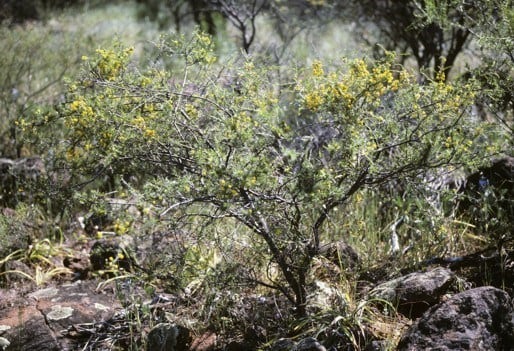Acacia nodiflora Benth.
WATTLE
Acacias of Australia
Family
Fabaceae
Distribution
Known from only two specific localities in the northern wheatbelt region of south-western W.A.
Description
Diffuse intricate shrub 0.6–2 m high, glabrous or puberulous to hirtellous. Terminal branchlets occasionally coarsely spiny. Stipules subtending phyllode-clusters, to 4 mm long, ±spinose, often only bases persistent. Phyllodes in subnodose fascicles of up to 7, linear to linear-oblanceolate, infrequently subterete, 7–13 mm long, 0.5–1.5 mm wide, excentrically mucronulate at rounded or obliquely truncate (sometimes subuncinate) apex, obscurely 1‑nerved per face; gland in ±basal half of phyllode. Inflorescences simple, 1–3 per axil; peduncles 1–2 cm long, glabrous or puberulous, sometimes bracteate in distal half; heads globular to shortly obloid, 25–55-flowered, golden. Flowers 5-merous; sepals free or united near base. Pods narrowly oblong, to 6.5 cm long, 7–8 mm wide, thinly crustaceous, yellow-brown. Seeds longitudinal, oblong, 5 mm long, dull, brown; aril slightly shiny.
Habitat
Grows among rocks on low hills.
Specimens
W.A.: Carnamah, W.E.Blackall 4370 (PERTH); Billeranga Hills, c. 20 km SW of Morawa, B.R.Maslin 5309 (K, PERTH).
Notes
Acacia scabra may simply be a variant of A. nodiflora with slightly larger than normal phyllodes, see that species for details.
A pair of spiny stipules subtends the clusters of phyllodes which are much-reduced branchlets with the internodes suppressed, so that the phyllodes are brought together in fascicles, the peduncles arising from the same abbreviated axis. In some specimens (e.g. B.R.Maslin 6230, K, MEL, PERTH from the Carnamah area) the axis is slightly, but sufficiently, elongated so as to reveal its true nature. The type and Carnamah specimens are less hairy than those from Billeranga Hills.
Related in a general sense to A. dentifera which has much larger, non-fascicled phyllodes with non-spinose stipules and indeterminate racemes or peduncles in axillary pairs and to A. kulinensis which has much smaller, differently shaped phyllodes. Also similar to A. adinophylla.
FOA Reference
Data derived from Flora of Australia Volumes 11A (2001), 11B (2001) and 12 (1998), products of ABRS, ©Commonwealth of Australia
Author
B.R.Maslin
Minor edits by B.R.Maslin
This identification key and fact sheets are available as a mobile application:
URL: https://apps.lucidcentral.org/wattle/
© Copyright 2018. All rights reserved.









